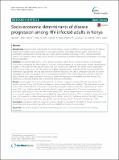| dc.contributor.author | Gitahi–Kamau, Nyawira T. | |
| dc.contributor.author | Kiarie, James N. | |
| dc.contributor.author | Mutai, Kenneth K. | |
| dc.contributor.author | Gatumia, Beatrice W. | |
| dc.contributor.author | Gatongi, P. M. | |
| dc.contributor.author | Lakati, A. | |
| dc.date.accessioned | 2021-08-26T09:54:33Z | |
| dc.date.available | 2021-08-26T09:54:33Z | |
| dc.date.issued | 7/31/2015 | |
| dc.identifier.citation | Gitahi–Kamau, N.T., Kiarie, J.N., Mutai, K.K. et al. Socio-economic determinants of disease progression among HIV infected adults in Kenya. BMC Public Health 15, 733 (2015). https://doi.org/10.1186/s12889-015-2084-8 | en_US |
| dc.identifier.uri | http://repository.amref.org/handle/123456789/150 | |
| dc.description | © 2015 Gitahi-Kamau et al. This is an Open Access article distributed under the terms of the Creative Commons Attribution
License (http://creativecommons.org/licenses/by/4.0), which permits unrestricted use, distribution, and reproduction in any
medium, provided the original work is properly credited. The Creative Commons Public Domain Dedication waiver (http://
creativecommons.org/publicdomain/zero/1.0/) applies to the data made available in this article, unless otherwise stated | en_US |
| dc.description.abstract | Background: Socioeconomic determinants have been shown to have an effect on the progression of HIV disease
evidenced by studies carried out largely in developed countries. Knowledge of these factors could inform on
prioritization of populations during scale up of highly active antiretroviral therapy (HAART) constrained health
systems. The objective of this study was to identify socioeconomic correlates of HIV disease progression in an adult
Kenyan population.
Methods: We analysed data from 312 HIV positive individuals, drawn from a cohort enrolled in a randomized
clinical trial investigating the effectiveness of Acyclovir in the prevention of HIV transmission among serodiscordant
couples. In this study we included individuals with CD4 counts ≥ 350 cells/mm3 and World Health Organization
(WHO), clinical stage one or two. The exposure variables measured were: - daily household income available for
expenditure, age, gender, housing type and level of formal education. We used a composite outcome of disease
progression to WHO clinical stage 3 or 4 or a laboratory outcome of CD4 count below 350 cells/mm3 after two
years of follow-up. Logistic regression was used to determine associations of variables that were found to be
significant at univariate analysis, and to control for potential confounders.
Results: Seventy eight (25 %) individuals reported HIV disease progression. Majority (79.9 %) were female. The
median age was 30 year and 93.6 % had attained a primary level of education. Median CD4 at enrolment into the
clinical trial was 564 cells/mm3
; those who had disease progression were enrolled with a significantly (p < 0.001)
lower CD4 count. Daily household income available for expenditure adjusted for CD4 count at enrolment was
associated significantly (p = 0.04) with HIV disease progression. Disease progression was five times more likely to
occur in study subjects with daily income available for expenditure of less than US$1 compared to those with more
than US$ 5 available for daily expenditure [adjusted Odds Ratio 4.6 (95 % Confidence Interval 1.4–14.4)]. Disease
progression was not associated with age, gender, type of housing or level of education attained (p < 0.05).
Conclusion: Populations with low household incomes should be considered vulnerable to disease progression and
should therefore be prioritized during the scale up of HAART for treatment as prevention. | en_US |
| dc.language.iso | en | en_US |
| dc.publisher | BioMed Central | en_US |
| dc.subject | Discordant | en_US |
| dc.subject | Highly active antiretroviral therapy | en_US |
| dc.subject | Income | en_US |
| dc.subject | Socio-economic determinants | en_US |
| dc.subject | Disease progression | en_US |
| dc.title | Socio-economic Determinants of Disease Progression among HIV Infected Adults in Kenya | en_US |
| dc.type | Article, Journal | en_US |

